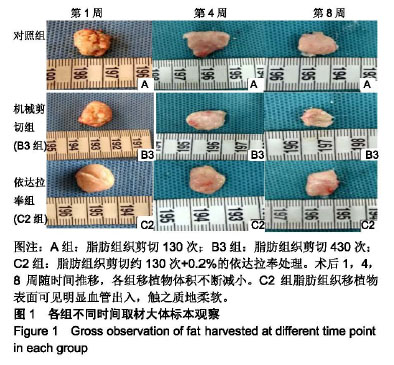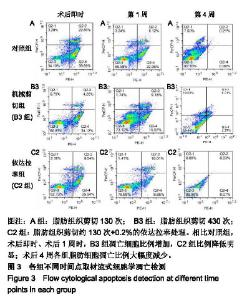Chinese Journal of Tissue Engineering Research ›› 2019, Vol. 23 ›› Issue (35): 5652-5657.doi: 10.3969/j.issn.2095-4344.1486
Previous Articles Next Articles
Variables affecting the retained volume of adipose tissue after transplantation in rats
Jia Daping, Ma Li, Wu Liangliang, Zhao Yu
- (Department of Plastic Surgery, First Affiliated Hospital of Anhui Medical University, Hefei 230022, Anhui Province, China)
-
Received:2019-05-21Online:2019-12-18Published:2019-12-18 -
Contact:Zhao Yu, MD, Professor, Department of Plastic Surgery, First Affiliated Hospital of Anhui Medical University, Hefei 230022, Anhui Province, China -
About author:Jia Daping, Master candidate, Department of Plastic Surgery, First Affiliated Hospital of Anhui Medical University, Hefei 230022, Anhui Province, China -
Supported by:Funding: the National Natural Science Foundation, No. 81171829 (to ZY)
CLC Number:
Cite this article
Jia Daping, Ma Li, Wu Liangliang, Zhao Yu. Variables affecting the retained volume of adipose tissue after transplantation in rats[J]. Chinese Journal of Tissue Engineering Research, 2019, 23(35): 5652-5657.
share this article
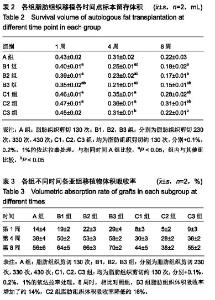
术后1周时,各组移植物观察未见明显差异,移植物呈细颗粒状,表面偶见血性渗液,质地柔软,受区皮肤可见血管增生。术后4周,各组脂肪组织表面皆有新生血管形成,可见纤维组织包膜包裹,移植物质韧,B组偶可触及块状组织,脂肪组织留存体积较对照组下降明显,C1和C2组体积留存较对照组提升明显。术后8周,各组移植脂肪组织体积进一步缩小,但缩小幅度相比4周时小,各组体积留存比较结果与4周时相同,可见血管穿入脂肪团内,B3组标本表面纤维组织包膜厚实,脂肪色黄白,质韧,C1和C2组脂肪组织移植物表面可见明显血管出入,触之质地柔软,C2组最接近正常脂肪组织。 2.3 不同时间各组术后移植物留存体积情况 各组术后脂肪组织平均体积留存记录见表2。各组不同时间各亚组移植物体积吸收率见表3。"
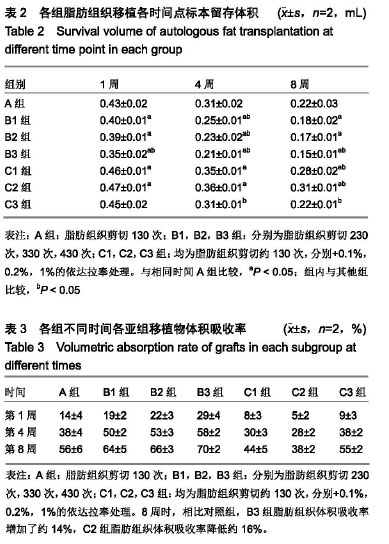

表2结果表明,随时间延长,大鼠移植后脂肪体积不断缩小,对同期所有实验亚组与对照组比较,7个亚组间数据具有方差齐性,行单因素方差分析,7个组间移植物留存体积不完全相等(F1周=45.768、F4周=122.049、F8周=59.245,P < 0.05),其中B组移植物留存体积较对照组小,C1和C2移植物留存体积显著大于对照组(P < 0.05)。对同一时期B组、C组内亚组间两两对比留存体积,行SNK检验,1周时,B3对比B1、B2组移植物留存体积明显较小(FB组组间= 16.422,P < 0.05),C组各亚组移植物留存体积差异无显著性意义(FC组组间=3.256,P > 0.05);4周时,B组各亚组移植物留存体积成梯度下降,B3<B2<B1,C1、C2对比C3组移植物留存体积显著增加(FB组组间=18.514,FC组组间= 35.975,P < 0.05);8周时B3与B1留存体积比较明显缩小(FB组组间=4.339,P < 0.05),C组各亚组移植物留存体积从大到小排序为C2>C1>C3,差异有显著性意义(FC组组间= 44.322,P < 0.05)。以上统计结果表明,大鼠自体脂肪组织移植中给予获取的脂肪浓度不超过0.2%的依达拉奉注射能明显提高移植后脂肪组织体积留存率,机械剪切会显著降低脂肪组织移植后体积留存。 表3结果显示,8周时,相比对照组,B3组脂肪组织体积吸收率增加了约14%,C2组脂肪组织体积吸收率降低约16%,C3组移植后脂肪吸收率与同期对照组比较差异无显著性意义(P > 0.05)。 2.4 组织学比较 苏木精-伊红染色结果观察分析发现:术后1,4周时,各组脂肪细胞形态均维持较好,呈圆形或规则多边形,细胞壁完整,细胞核偏向一侧,细胞间间隙稳定,可见明显炎症细胞浸润;术后8周,对照组可见脂肪细胞体积不一,结构紊乱、毛细血管增生,纤维组织包饶脂肪细胞,B3组脂肪细胞排列紊乱,间质有纤维组织增生、炎性细胞浸润,可见脂肪细胞形态明显不规则,见较多脂肪空泡形成,C2组脂肪细胞轮廓清晰,细胞形态较规则,细胞体积较一致,可见丰富毛细血管增生,仅有少量脂肪空泡形成。B组、C组典型图片见图2。 "
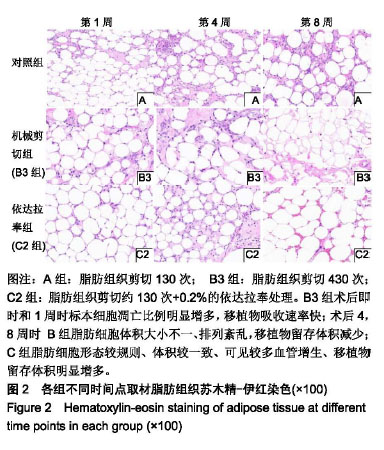
| [1]Sarkarat F.Fat Graft with Growth Factors. Atlas Oral Maxillofac Surg Clin North Am. 2018;26(1):33-39.[2]Leuchter I,Schweizer V,Hohlfeld J.Treatment of velopharyngeal insufficiency by autologous fat injection. Eur Arch Otorhinolaryngol. 2010;267(6):977-983. [3]Coleman SR.Structural fat grafts: the ideal filler?. Clin Plast Surg. 2001;28(1):111-119.[4]Karaçal N,Cobano?lu U,Ambarcio?lu O.The effect of fibrin glue on fat graft survival. J Plast Reconstr Aesthet Surg. 2007;60(3): 300-303.[5]Yu Q,Cai Y,Huang H,et al.Co-Transplantation of Nanofat Enhances Neovascularization and Fat Graft Survival in Nude Mice. Aesthet Surg J. 2018;38(6):667-675.[6]Coleman SR.Hand rejuvenation with structural fat grafting. Plast Reconstr Surg. 2002;110(7):1731-1744; discussion 1745-1747.[7]Coleman SR.Long-term survival of fat transplants: controlled demonstrations. Aesthetic Plast Surg. 1995;19(5):421-425.[8]Coleman SR.Facial recontouring with lipostructure. Clin Plast Surg. 1997;24(2):347-367.[9]Por YC,Yeow VK,Louri N,et al.Platelet-rich plasma has no effect on increasing free fat graft survival in the nude mouse. J Plast Reconstr Aesthet Surg. 2009;62(8):1030-1034. [10]Pires Fraga MF,Nishio RT,Ishikawa RS,et al.Increased survival of free fat grafts with platelet-rich plasma in rabbits. J Plast Reconstr Aesthet Surg. 2010;63(12):e818-22.[11]Ding SL, Zhang MY, Tang SJ,et al. Effect of Calcium Alginate Microsphere Loaded With Vascular Endothelial Growth Factor on Adipose Tissue Transplantation.Ann Plast Surg.2015; 75(6): 644-651.[12]Raposio E.How to isolate a ready-to-use adipose-derived stem cells pellet for clinical application. Eur Rev Med Pharmacol Sci. 2017;21(18):4252-4260. [13]von Heimburg D,Hemmrich K,Haydarlioglu S,et al.Comparison of viable cell yield from excised versus aspirated adipose tissue. Cells Tissues Organs. 2004;178(2):87-92. [14]Wolter TP,von Heimburg D,Stoffels I,et al.Cryopreservation of mature human adipocytes: in vitro measurement of viability. Ann Plast Surg. 2005;55(4):408-413.[15]Lee JH,Kirkham JC,McCormack MC,et al.The effect of pressure and shear on autologous fat grafting. Plast Reconstr Surg. 2013; 131(5):1125-1136.[16]Lapchak PA.A critical assessment of edaravone acute ischemic stroke efficacy trials: is edaravone an effective neuroprotective therapy?. Expert Opin Pharmacother. 2010;11(10):1753-1763.[17]Inokuchi Y,Imai S,Nakajima Y,et al.Edaravone, a free radical scavenger, protects against retinal damage in vitro and in vivo. J Pharmacol Exp Ther. 2009;329(2):687-698.[18]Qin T,Lei LY,Li N,et al.Edaravone improves survival and neurological outcomes after CPR in a ventricular fibrillation model of rats. Am J Emerg Med. 2016;34(10):1944-1949.[19]Amemiya S,Kamiya T,Nito C,et al.Anti-apoptotic and neuroprotective effects of edaravone following transient focal ischemia in rats. Eur J Pharmacol. 2005;516(2):125-130.[20]赵贤忠,孙纪燕,项铁,等.三种获取方法对脂肪细胞损伤程度的比较[J].中国临床康复,2006,10(21):103-105.[21]Hong KY,Yim S,Kim HJ,et al.The Fate of the Adipose-Derived Stromal Cells during Angiogenesis and Adipogenesis after Cell-Assisted Lipotransfer. Plast Reconstr Surg. 2018;141(2): 365-375.[22]Neuber GA.Fetttran splantation.Vehr Dtsch Ges Chir.1893;22:66.[23]Brunning P.Contribution à l’étude des greffes adipeuses.Bull Mem Acad R Med Belg.1919;28:440.[24]Kling RE, Mehrara BJ, Pusic AL, et al.Trends in Autologous Fat Grafting to the Breast. Plast Reconstr Surg. 2013;132(1):35-46.[25]Ozkaya O,Egemen O,Barutça SA.Long-term clinical outcomes of fat grafting by low-pressure aspiration and slow centrifugation (Lopasce technique) for different indications. J Plast Surg Hand Surg. 2013;47(5):394-398.[26]Yi C,Pan Y,Zhen Y,et al.Enhancement of viability of fat grafts in nude mice by endothelial progenitor cells. Dermatol Surg. 2006; 32(12):1437-1443. [27]Eto H,Kato H,Suga H,et al.The fate of adipocytes after nonvascularized fat grafting: evidence of early death and replacement of adipocytes. Plast Reconstr Surg. 2012;129(5): 1081-1092.[28]Coleman SR. Long-term survival of fat transplants: controlled demonstrations. Aesthetic Plast Surg. 1995;19(5):421-425.[29]Kanchwala SK.Facial fat grafting: the search for predictable results. Facial Plast Surg. 2003;19(1):137-146.[30]Mikus JL,Koufman JA.Fate of liposuctioned and purified autologous fat injections in the canine vocal fold. Laryngoscope. 1995;105(1):17-22.[31]Gillis J,Gebremeskel S,Phipps KD,et al.Effect of N-Acetylcysteine on Adipose-Derived Stem Cell and Autologous Fat Graft Survival in a Mouse Model. Plast Reconstr Surg. 2015;136(2):179e-188e. [32]Wang WZ,Fang XH,Williams SJ,et al.Analysis for apoptosis and necrosis on adipocytes, stromal vascular fraction, and adipose-derived stem cells in human lipoaspirates after liposuction. Plast Reconstr Surg. 2013;131(1):77e-85e.[33]Witort EJ,Pattarino J,Papucci L,et al.Autologous lipofilling: coenzyme Q10 can rescue adipocytes from stress-induced apoptotic death. Plast Reconstr Surg. 2007;119(4):1191-1199.[34]雷华,李青峰.抽吸负压对所抽吸脂肪颗粒活性影响的研究[J].中国美容医学,2005,14(1):27-30.[35]柳丛,李云霞,叶媛,邹敬江,胡葵葵.提高脂肪移植存活成功率的研究进展[J].中国美容医学,2018,27(10):155-159.[36]Toledo LS,Mauad R. Fat injection:a 20-year revision.Clin Plast Surg.2006;33:47-53.[37]Rose JG,Lucarelli MJ,Lemke BN,et al.Histologic comparison of autologous fat processing methods. Ophthalmic Plast Reconstr Surg. 2006;22(3):195-200. |
| [1] | Geng Qiudong, Ge Haiya, Wang Heming, Li Nan. Role and mechanism of Guilu Erxianjiao in treatment of osteoarthritis based on network pharmacology [J]. Chinese Journal of Tissue Engineering Research, 2021, 25(8): 1229-1236. |
| [2] | Pei Lili, Sun Guicai, Wang Di. Salvianolic acid B inhibits oxidative damage of bone marrow mesenchymal stem cells and promotes differentiation into cardiomyocytes [J]. Chinese Journal of Tissue Engineering Research, 2021, 25(7): 1032-1036. |
| [3] | Li Shibin, Lai Yu, Zhou Yi, Liao Jianzhao, Zhang Xiaoyun, Zhang Xuan. Pathogenesis of hormonal osteonecrosis of the femoral head and the target effect of related signaling pathways [J]. Chinese Journal of Tissue Engineering Research, 2021, 25(6): 935-941. |
| [4] | Xu Yinqin, Shi Hongmei, Wang Guangyi. Effects of Tongbi prescription hot compress combined with acupuncture on mRNA expressions of apoptosis-related genes,Caspase-3 and Bcl-2, in degenerative intervertebral discs [J]. Chinese Journal of Tissue Engineering Research, 2021, 25(5): 713-718. |
| [5] | Zhang Wenwen, Jin Songfeng, Zhao Guoliang, Gong Lihong. Mechanism by which Wenban Decoction reduces homocysteine-induced apoptosis of myocardial microvascular endothelial cells in rats [J]. Chinese Journal of Tissue Engineering Research, 2021, 25(5): 723-728. |
| [6] | Liu Qing, Wan Bijiang. Effect of acupotomy therapy on the expression of Bcl-2/Bax in synovial tissue of collagen-induced arthritis rats [J]. Chinese Journal of Tissue Engineering Research, 2021, 25(5): 729-734. |
| [7] | Xie Chongxin, Zhang Lei. Comparison of knee degeneration after anterior cruciate ligament reconstruction with or without remnant preservation [J]. Chinese Journal of Tissue Engineering Research, 2021, 25(5): 735-740. |
| [8] | Su Liping, Lu Ziyang, Liu Li, Zhang Wei, Su Tianyuan, Hu Xiayun, Pu Hongwei, Han Dengfeng. C-jun, Cytc and Caspase-9 in the apoptosis of cerebellar granule neurons induced by diacetylmorphine in rats [J]. Chinese Journal of Tissue Engineering Research, 2021, 25(25): 3943-3948. |
| [9] | Zuo Zhenkui, Han Jiarui, Ji Shuling, He Lulu. Pretreatment with ginkgo biloba extract 50 alleviates radiation-induced acute intestinal injury in mice [J]. Chinese Journal of Tissue Engineering Research, 2021, 25(23): 3666-3671. |
| [10] | Zhang Liang, Ma Xiaoyan, Wang Jiahong. Regulatory mechanism of Shenshuai Yin on cell apoptosis in the kidney of chronic renal failure rats [J]. Chinese Journal of Tissue Engineering Research, 2021, 25(23): 3672-3677. |
| [11] | Xie Yang, Lü Zhiyu, Zhang Shujiang, Long Ting, Li Zuoxiao. Effects of recombinant adeno-associated virus mediated nerve growth factor gene transfection on oligodendrocyte apoptosis and myelination in experimental autoimmune encephalomyelitis mice [J]. Chinese Journal of Tissue Engineering Research, 2021, 25(23): 3678-3683. |
| [12] | Xu Bin, Yang Xiushu, Liu Xuan, Wang Zhenxing. Changes of intestinal epithelial cells and their apoptotic factors Caspase-3, Bax and Bcl-2 under urinary environment [J]. Chinese Journal of Tissue Engineering Research, 2021, 25(20): 3173-3177. |
| [13] | Song Shilei, Chen Yueping, Zhang Xiaoyun, Li Shibin, Lai Yu, Zhou Yi. Potential molecular mechanism of Wuling powder in treating osteoarthritis based on network pharmacology and molecular docking [J]. Chinese Journal of Tissue Engineering Research, 2021, 25(20): 3185-3193. |
| [14] | Liu Kun, Xie Lin, Cao Jun, Ding Ning, Xu Lingbo, Ma Shengchao, Li Guizhong , Jiang Yideng, Lu Guanjun. Increased FoxO1 DNA methylation level in homocysteine-induced podocyte apoptosis [J]. Chinese Journal of Tissue Engineering Research, 2021, 25(2): 269-273. |
| [15] | Yan Xiurui, Tao Jin, Liang Xueyun. Mechanism by which exosomes from human fetal placental mesenchymal stem cells protect lung epithelial cells against oxidative stress injury [J]. Chinese Journal of Tissue Engineering Research, 2021, 25(19): 2994-2999. |
| Viewed | ||||||
|
Full text |
|
|||||
|
Abstract |
|
|||||

